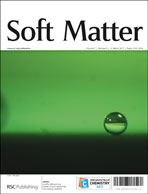Self-assembly of cellulose nanofibrils by genetically engineered fusion proteins†
Abstract
One central problem for the function and manufacture of materials where performance relies on nanoscale structure is to control the compatibility and interactions of the building blocks. In natural materials, such as nacre, there are examples of multifunctional


 Please wait while we load your content...
Please wait while we load your content...